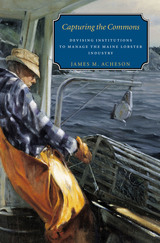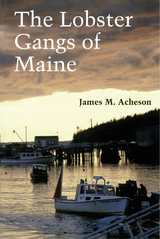247 scholarly books by University Press of New England and 9
have author last names that start with A
247 scholarly books by University Press of New England and 9
247 scholarly books by University Press of New England
9 have author last names that start with A have author last names that start with A
9 have author last names that start with A have author last names that start with A

Capturing the Commons
Devising Institutions to Manage the Maine Lobster Industry
James M. Acheson
University Press of New England, 2004
One of the most pressing concerns of environmentalists and policy makers is the overexploitation of natural resources. Efforts to regulate such resources are too often undermined by the people whose livelihoods depend on their use. One of the great challenges for wildlife managers in the twenty-first century is learning to create the conditions under which people will erect effective and workable rules to conserve those resources. James M. Acheson, author of the best-selling Lobster Gangs of Maine (the seminal work on the culture and economics of lobster fishing), here turns his attention to the management of the lobster industry. In this illuminating new book, he shows that resource degradation is not inevitable. Indeed, the Maine lobster fishery is one of the most successful fisheries in the world. Catches have been stable since World War II, and record highs have been achieved since the late 1980s. According to Acheson, these high catches are due, in part, to the institutions generated by the lobster-fishing industry to control fishing practices. These rules are effective. Rational choice theory frames Acheson’s down-to-earth study. Rational choice theorists believe that the overexploitation of marine resources stems from their common-pool nature, which results in collective action problems. In fisheries, what is rational for the individual fishermen can lead to disaster for the society. The progressive Maine lobster industry, lobster fishermen, and local groups have solved a series of such problems by creating three different sets of regulations: informal territorial rules; rules to control the number of traps; and formal conservation legislation. In recent years, the industry has successfully influenced new regulations at the federal level and has developed a strong co-management system with the Maine government. The process of developing these rules has been quite acrimonious; factions of fishermen have disagreed over lobster rules designed to give commercial advantage to one group or another. Although fishermen and scientists have come to share a conservation ethic, they often disagree over how to best conserve the lobster and even the quality of science. The importance of Capturing the Commons is twofold: it provides a case study of the management of one highly successful fishery, which can serve as a management model for policy makers, politicians, and local communities; and it adds to the body of theory concerning the conditions under which people will and will not devise institutions to manage natural resources.
[more]

The Lobster Gangs of Maine
James M. Acheson
University Press of New England, 1988
James Acheson’s detailed account of lobstering in Maine quickly dispels notions that the lobstermen is the eastern version of the cowboy, struggling alone for survival against the elements. In reality, he writes, “the lobster fisherman is caught up in a thick and complex web of social relationships. Survival in the industry depends as much on the ability to manipulate social relationships as on technical skills.” Acheson replaces our romantic image of the lobsterman with descriptions of the highly territorial and hierarchical “harbor gangs,” daily and annual cycles of lobstering, intricacies of marketing the catch, and the challenge of managing a communal resource.
[more]

The New Hiking the Monadnock Region
44 Nature Walks and Day-Hikes in the Heart of New England
Joe Adamowicz
University Press of New England, 2007
The New Hiking the Monadnock Region will lead you through forests and meadows, over small mountains and gentle hills, around ponds and sanctuaries, and along streams and abandoned roads. This detailed and informative guide, fully expanded and updated, now includes a beautifully rendered map for each hike and also provides information on flora and fauna, as well as local history and nearby sightseeing destinations. In addition, the book contains specialized information for the beginning hiker and for parents hiking with children, lists of hiking and conservation organizations, and other helpful resources. Whether you’re a seasoned hiker, a family with children, an amateur naturalist, a lifelong resident of the region, or a visitor, this is your essential guide to enjoying one of the most popular outdoor recreation spots in the northeast.
[more]

The Decibel Diaries
A Journey through Rock in 50 Concerts
Carter Alan
University Press of New England, 2017
Sometimes a rock concert is more than just an event. Every so often a band’s performance becomes a musical milestone, a cultural watershed, a political statement, and a personal apotheosis. On any given night a rock concert can tell the truth about who we are, where we are, and what’s going on in music and life right now. In The Decibel Diaries, Carter Alan, longtime DJ and music director at WZLX in Boston, chronicles a lifetime in rock with a tour through fifty concerts that defined such moments—from Crosby, Stills, Nash & Young playing in the rain when Richard Nixon resigned to Talking Heads and the first stirrings of punk in the basement bars of New York and Boston to the bluegrass angel Alison Krauss and the adaptable veteran Robert Plant forging a plangent, plaintive postmodern synergy. For each event Alan shows us what it was like to be there and telescopes out to reveal how this show fit into the arc of the artist’s career, the artist’s place in music, and the music’s place in the wider world. Taken together, The Decibel Diaries is a visceral and visionary portrait of nearly fifty years of rock ’n’ roll.
[more]

Radio Free Boston
The Rise and Fall of WBCN
Carter Alan
University Press of New England, 2013
Blaring the Cream anthem “I Feel Free,” WBCN went on the air in March 1968 as an experiment in free-form rock on the fledgling FM radio band. It broadcast its final song, Pink Floyd’s “Shine On You Crazy Diamond,” in August 2009. In between, WBCN became the musical, cultural, and political voice of the young people of Boston and New England, sustaining a vibrant local music scene that launched such artists as the J. Geils Band, Aerosmith, James Taylor, Boston, the Cars, and the Dropkick Murphys, as well as paving the way for Bruce Springsteen, Tom Petty, U2, and many others. Along the way, WBCN both pioneered and defined progressive rock radio, the dominant format for a generation of listeners. Brilliantly told by Carter Alan—and featuring the voices of station insiders and the artists they loved—Radio Free Boston is the story of a city; of artistic freedom, of music and politics and identity; and of the cultural, technological, and financial forces that killed rock radio.
[more]

The Story of a Bad Boy
Thomas Bailey Aldrich
University Press of New England, 1996
In 1869 Thomas Bailey Aldrich introduced to American literature the original “bad boy”--that all-American boy who plays harmless pranks, devises exciting adventures, has an occasional bout of love-sickness, is bored on Sundays, and is well-liked by almost everyone. Later followed by Mark Twain’s The Adventures of Tom Sawyer and The Adventures of Huckleberry Finn, The Story of a Bad Boy--once called the first truly American novel--is Aldrich’s partially autobiographical tale of growing up in America. Set in Rivermouth (based on Aldrich’s childhood home in Portsmouth, New Hampshire), it follows the exploits of young Tom Bailey through snowball wars, schoolyard fights, Fourth of July parades, adventures at sea, and childhood sweathearts. Now printed in more than fifty editions and read and beloved by Americans for over a century, Aldrich’s classic is ready to be rediscovered by a new generation of readers.
[more]

The Great Siege of Malta
The Epic Battle between the Ottoman Empire and the Knights of St. John
Bruce Ware Allen
University Press of New England, 2017
In the spring of 1565, a massive fleet of Ottoman ships descended on Malta, a small island centrally located between North Africa and Sicily, home and headquarters of the crusading Knights of St. John and their charismatic Grand Master, Jean de Valette. The Knights had been expelled from Rhodes by the Ottoman sultan, Suleiman the Magnificent, and now stood as the last bastion against a Muslim invasion of Sicily, southern Italy, and beyond. The siege force of Turks, Arabs, and Barbary corsairs from across the Muslim world outnumbered the defenders of Malta many times over, and its arrival began a long hot summer of bloody combat, often hand to hand, embroiling knights and mercenaries, civilians and slaves, in a desperate struggle for this pivotal point in the Mediterranean. Bruce Ware Allen's The Great Siege of Malta describes the siege’s geopolitical context, explains its strategies and tactics, and reveals how the all-too-human personalities of both Muslim and Christian leaders shaped the course of events. The siege of Malta was the Ottoman empire’s high-water mark in the war between the Christian West and the Muslim East for control of the Mediterranean. Drawing on copious research and new source material, Allen stirringly recreates the two factions’ heroism and chivalry, while simultaneously tracing the barbarism, severity, and indifference to suffering of sixteenth-century warfare. The Great Siege of Malta is a fresh, vivid retelling of one of the most famous battles of the early modern world—a battle whose echoes are still felt today.
[more]

Tiber
Eternal River of Rome
Bruce Ware Allen
University Press of New England, 2018
In this rich history of Italy’s Tiber River, Bruce Ware Allen charts the main currents, mythic headwaters, and hidden tributaries of one of the world’s most renowned waterways. He considers life along the river, from its twin springs high in the Apennines all the way to its mouth at Ostia, and describes the people who lived along its banks and how they made the Tiber work for them. The Tiber has served as the realm of protomythic creatures and gods, a battleground for armies and navies, a livelihood for boatmen and fishermen, the subject matter of poets and painters, and the final resting place for criminals and martyrs. Tiber: Eternal River of Rome is a highly readable history and a go-to resource for information about Italy’s most storied river.
[more]

The Battle for the Fourteenth Colony
America’s War of Liberation in Canada, 1774–1776
Mark R. Anderson
University Press of New England, 2013
In this dramatic retelling of one of history’s great “what-ifs,” Mark R. Anderson examines the American colonies’ campaign to bring Quebec into the Continental confederation and free the Canadians from British “tyranny.” This significant reassessment of a little-studied campaign examines developments on both sides of the border that rapidly proceeded from peaceful diplomatic overtures to a sizable armed intervention. The military narrative encompasses Richard Montgomery’s plodding initial operations, Canadian partisan cooperation with officers like Ethan Allen, and the harrowing experiences of Benedict Arnold’s Kennebec expedition, as well as the sudden collapse of British defenses that secured the bulk of the province for the rebel cause. The book provides new insight into both Montgomery’s tragic Québec City defeat and a small but highly significant loyalist uprising in the rural northern parishes that was suppressed by Arnold and his Canadian patriot allies. Anderson closely examines the evolving relationships between occupiers and occupied, showing how rapidly changing circumstances variously fostered cooperation and encouraged resistance among different Canadian elements. The book homes in on the key political and military factors that ultimately doomed America’s first foreign war of liberation and resulted in the Continental Army’s decisive expulsion from Canada on the eve of the Declaration of Independence. The first full treatment of this fascinating chapter in Revolutionary War history in over a century, Anderson’s account is especially revealing in its presentation of contentious British rule in Quebec, and of Continental beliefs that Canadiens would greet the soldiers as liberators and allies in a common fight against the British yoke. This thoroughly researched and action-packed history will appeal to American and Canadian history buffs and military experts alike.
[more]
READERS
Browse our collection.
PUBLISHERS
See BiblioVault's publisher services.
STUDENT SERVICES
Files for college accessibility offices.
UChicago Accessibility Resources
home | accessibility | search | about | contact us
BiblioVault ® 2001 - 2024
The University of Chicago Press









